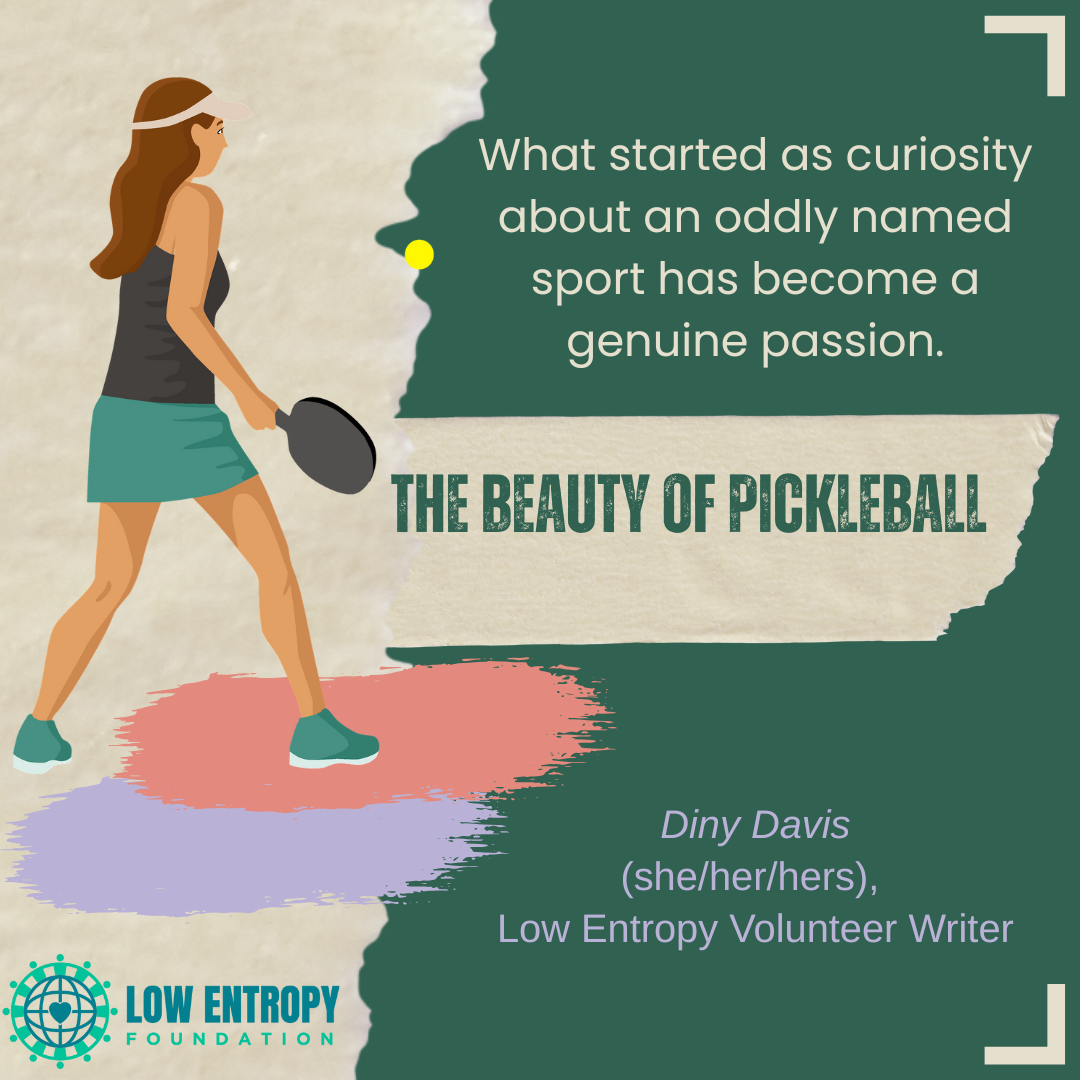Neda Ziabakhsh, Low Entropy Volunteer Writer
“Sports do not build character. Sports reveal character.” – Heywood Hale Broun
My First Encounter with Pickleball
This summer, I decided to try playing pickleball. I had never played it before but had heard the name of this sport and how it was becoming popular everywhere. I watched a couple of videos about pickleball, discovering that it was played with paddles and a plastic ball. I was both curious and skeptical as I wondered how safe it would be for me to start playing a sport after decades and how my body might react to it. But something about this sport made me want to give it a try.
The local community center had courts that looked like miniature tennis courts and I watched a few games before my first attempt. What struck me immediately was the diversity of players—teenagers playing alongside people in their late 60s, all seeming to have a blast. The sound of the plastic ball hitting paddles created this distinctive “pop” that soon motivated me to just hit that plastic ball and start a game.
Equipment and Court Setup
Getting started was surprisingly simple. I felt the paddle was like a cross between a ping pong paddle and a tennis racket—lightweight but solid. The court itself was 20 by 44 feet, about a quarter the size of a tennis court, with a net that sits 36 inches high at the ends and 34 inches in the middle.
Basic Rules and Scoring
The scoring system confused me at first. Games are played to 11 points and you can only score when you or your team is serving. The server calls out three numbers: their score, the opponent’s score and which server they are (first or second). So you might hear “5-3-2” which means the serving team has five points, the receiving team has the three and it’s the second server’s turn.
What I loved immediately was the underhand serve requirement. Unlike tennis, where a powerful overhead serve can dominate, pickleball’s underhand serve keeps things more accessible and focused on strategy rather than pure power. This is another reason that allows even kids to play it easily.
The Physical Experience
My body felt completely comfortable on the pickleball court. The smaller court means less running and the lighter ball creates less strain on joints. Yet I was surprised by how much of a workout I got—lots of quick movements, constant engagement and, surprisingly, a lot of energy.
The plastic ball with holes travels much slower than a tennis ball, giving you more time to think about shot placement. Instead of trying to win, my main agenda was to enjoy the game.
Hand-Eye Coordination Challenges
Even though the ball moves slower, the quick exchanges at the net require sharp reflexes. These soft shots just over the net became addictive—there’s something satisfying about the control required to keep the ball low and just out of reach.
The Social Aspect
What hooked me wasn’t just the game itself, but the community around it. Within my first week, I knew the faces of a dozen regular players.
Age becomes almost irrelevant on the court. I’ve seen players in their 60s who could place the ball exactly where they wanted every time. Meanwhile, some younger, more athletic players struggled with the patience and precision the game demands. This game is for all age groups.
Learning from Others
The pickleball community is incredibly welcoming to beginners. Players regularly offer tips between games, and even from just watching from a distance. When I was struggling with my serve, a gentleman in his late 60s came to me and showed the perfect stance.
This teaching culture creates rapid improvement. Within a month, I jumped from a beginner stage to the next level. It helped me gain more strength and stamina to play for a longer duration.
Perfect Balance of Skill and Accessibility
Pickleball hits a sweet spot that many sports miss. It’s easy enough for beginners to enjoy from day one, but complex enough to provide years of skill development. Unlike some sports where physical limitations can create barriers, pickleball’s design allows people of different ages and fitness levels to compete meaningfully against each other.
Continuous Improvement
Every session brought noticeable improvement in some aspect of my game. Whether it was better serving placement, more consistent hits or improved court positioning, the learning curve felt rewarding, rather than frustrating. The combination of immediate feedback and supportive community created the perfect environment for skill development.
From Skeptic to Enthusiast
What started as curiosity about an oddly named sport has become a genuine passion. The beauty of pickleball lies not just in its accessibility, but in its ability to provide serious athletic competition while maintaining a fun, social atmosphere.
It’s proof that the best sports aren’t always the most established ones—sometimes the most rewarding experiences come from trying something completely new.
If you’re looking for a sport that combines strategy, community and pure fun while being gentle on your body, give pickleball a try. You might just discover your new favorite way to stay active.
—
Diny Davis is an aspiring author who is passionate about fitness and a strong believer in the close connection between physical and mental health. She is a journalism, psychology and literature graduate, a loving wife and a caring mother who maintains a balance in her work and personal lives while giving emphasis to self-care.
—


Beautifully written. Great going